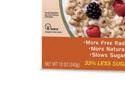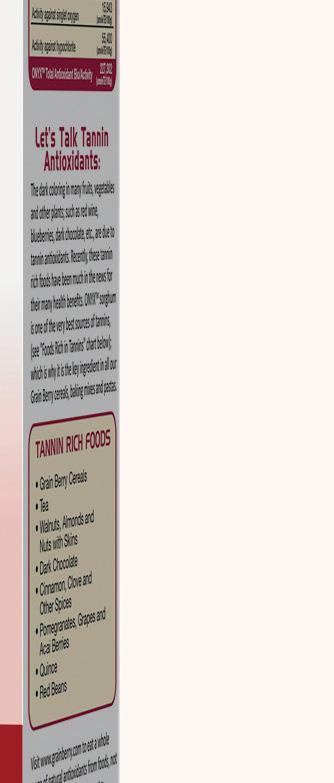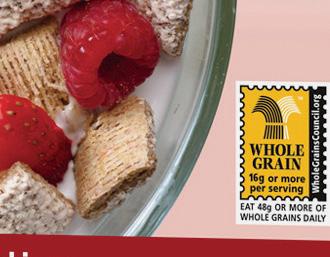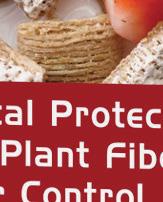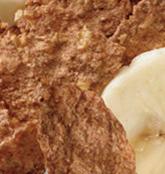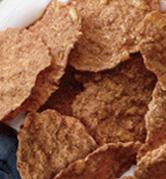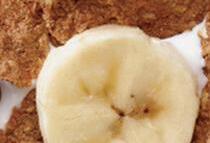
NEW PRODUCT















NEW PRODUCT

























Available in select stores.

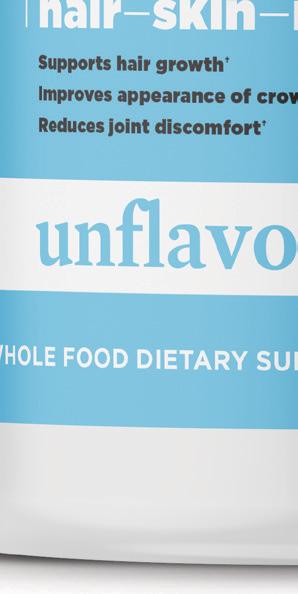
†













My email inbox for work is regularly filled with messages about sustainability and ways to live greener: everything from foods and drinks made from organic and non-GMO ingredients to regenerative farming practices, products packaged in eco-friendly materials, experts writing books about sustainable living and companies launching climatefriendly initiatives. So much of it is good stuff that I want to share with our readers.
At the recent Natural Products Expo, where several thousand companies from across the U.S. and around the world gathered to display their latest and greatest natural products—food, drinks, supplements, beauty care, cleaning supplies and more—one of the top trends was sustainability and upcycling. Today’s shoppers are concerned with climate change, excessive waste and preserving natural resources. Plastic packaging is one of the leading causes of landfill waste, and so many brands are turning to programs that utilize minimal or wastefree packaging to help reduce such waste.
Regenerative agriculture is also a hot topic. This holistic approach to farming, which was used by Indigenous communities long before industrial agriculture occurred, strives to keep soil healthy by growing a variety of crops in rotation to nurture soil’s naturally occurring microbiome and allow its many essential nutrients to be replenished. The result is healthier soil, healthier food and a healthier ecosystem. A growing number of food brands like Kashi, Lundberg Family Farms, Alter Eco, Applegate and Nature’s Path are incorporating these very regenerative practices into their food production.

I had the pleasure of interviewing farmer Lee Jones, a respected advocate—and practitioner—of regenerative farming, for this issue. On his family farm, The Chef’s Garden in Ohio, Farmer Lee and his team work around the belief that everything starts with health and balance of the soil, and that this leads to better-quality, better-tasting produce, as well as a healthier environment. This is likely a main reason that some of the top chefs in the country, including Wolfgang Puck and José Andrés, order produce from The Chef’s Garden for their restaurants.
If you have a family, trying to maintain a “sustainable” home can be challenging. So, we had one of our writers check in with an expert: Anita Vandyke, scientist, mom and author of a new book, A Zero Waste Family in Thirty Days . In our story, Vandyke shares some of her best tips about how to grocery shop and cook more sustainably, plus family-friendly tips for reducing waste in the kitchen.
Speaking of cooking, we have our usual array of delicious, healthy recipes. These include several from Farmer Lee’s new cookbook, The Chef’s Garden (pp. 16–17); super salads (pp. 18–20); and a selection of dishes using the fresh veggies of spring (pp. 21–23).
Spring is definitely the season of being green, and in this “green issue” we hope to inspire you with ways to live better and more sustainably. And, of course, eat well, too!
Rebecca Heaton, Editor editor@livenaturallymagazine.comBEGIN How to Live with Inflammation
PLUS Earth-minded eating, how to create a zero-waste lifestyle and how eating fruits and veggies reduces stress.
KITCHEN Better Dressings
PLUS Three of our favorite healthy snacks and five great kitchen gadgets.
EAT Chef It Up
Eat your veggies with Farmer Lee Jones.
Fast & Flavorful
A selection of super-healthy salads.
Healthy Kitchen
Recipes that celebrate spring produce.
BOOST Allergy Support
Natural supplements to get you through allergy season.
A Clean Sweep
Five supplements to remove toxins.
Calendula
This
supplement
Asparagus Bouquet Salad with Smoked Rosy Tahini Dressing, 19
Greens, Coconut Curry, 22

Hand-Rolled Vegetable Pasta, 17
Middle Eastern Couscous & Spinach Salad, 20

Nouveau Niçoise with Smoked Salmon, Jammy Eggs & Brilliant Potatoes, 18
Peas-and-Carrots Ice
Cream Sandwiches, 16
Shaved Asparagus Salad, 17
Spiced Green Pancakes, 23
The Greenest Pasta (Spaghetti with Peas, Broccolini & Kale Pesto), 21


Order
with your preferred Kroger retailer HEALTHY MADE EASY Look for QR codes throughout the magazine to shop a recipe!



Part of the Live Naturally family of Kroger magazines
SPRING 2022 livenaturallymagazine.com
VICE PRESIDENT OF CUSTOM PUBLISHING
Brendan Harrington
VICE PRESIDENT & GROUP PUBLISHER
Deborah Juris
KOMBUCHA COCKTAILS
ROASTED ASPARAGUS
EDITOR
Rebecca Heaton
CREATIVE DIRECTOR
Lindsay Burke
DEVILED EGGS
DESIGNER/DIGITAL
Shannon Moore
COPY EDITOR
Julie Van Keuren
FRESH GREENS
STRAWBERRY SORBET
GREEN SMOOTHIES

DIRECTOR BUSINESS
OPERATIONS
Devin Steinberg
CONTRIBUTING WRITERS
Nancy Coulter-Parker
Heidi Fritz
Kathryn Leavitt
Amelia Noel
Sarah Protzman Howlett
ADVERTISING SALES
Deborah Juris
PUBLISHED BY www.apg.alive.com

800.852.0857
GRILLED ARTICHOKES
Maggie Berghoff has created an easy-to-follow plan for living your best and healthiest life based on your specific inflammation type.
 BY REBECCA HEATON
BY REBECCA HEATON
We all live with inflammation every day; our bodies need it to function. But when we have too much of it—aka, chronic inflammation— then problems arise. Enter Maggie Berghoff, a functional medicine and family nurse practitioner who, through her own health struggles, created a three-step plan in her new book Eat Right for Your Inflammation Type (Atria, 2021) to help people live free of major types of inflammation, including those triggered by hormones, digestive issues, stress, allergies and rheumatoid arthritis. We caught up with her to learn more.
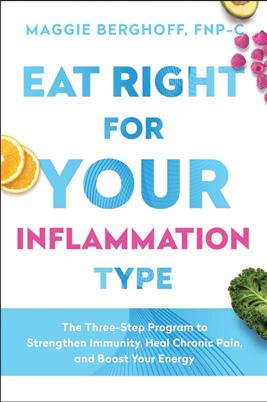
What inspired you to write this book?
My own health journey, which started in my 20s with symptoms like bloating, fatigue and hair loss. I tried to brush these off, but then things got worse: I was swelling up, gaining weight and falling asleep in class. I was studying to be a traditional nurse practitioner, then discovered functional medicine and began focusing more on nutrition, mindset and lifestyle—and I started to feel better. When I opened my own functional medicine practice, I found myself repeating so many things about inflammation to my clients that I decided I had to get this information out there so anyone could learn about it.
Please explain what inflammation is.
Inflammation is normal and keeps our body alive and safe. For example, if we have
a virus, our body inflames to get rid of the virus. Maybe you get bitten by a spider, and the spot puffs up and turns red. That’s good inflammation to get rid of the poison to heal the area.
But if someone is struggling with physical (e.g., achiness) or mental (e.g., irritability) issues, this could be caused by chronic inflammation. Inflammation comes from many things: bacteria or a virus; chemicals in food or drinks; or psychosocial things like stress. We have inflammation all of the time. But I don’t want people to be afraid of this because it’s a part of living. Instead, I want them to reduce inflammation where they can control it, like changing what they eat or drink, or the products they use on their skin, all of
which can contain toxins. Or making lifestyle changes.
In these COVID times, are inflammation and immunity connected? No matter how healthy you are, you can get COVID. But I don’t want anyone to live in fear, I want you to do whatever you can to handle the situation. The stress of fear can cause inflammation. So, it’s important to focus on boosting your immune system and lowering any inflammation. Then your body will have more energy to battle the virus.
What are some good antiinflammatory pantry items? If you love pasta, swap it for an organic, gluten-free option. A lot of condiments and pasta sauces have added sugar and chemicals, so I recommend swapping them for healthier options. Like ranch
dressing? Get one with no added cane sugar or food dye. Like to use seasoning packets for tacos or sloppy joes? Read the labels to find healthier options with fewer hard-to-read ingredients. They’re out there.
What lifestyle changes can people make to positively affect inflammation?
First and foremost, adjust your mindset to intend that positive changes will be happening in your life. Then simplify your meals, your supplements routine, your daily routine. Let loose of stress. Prioritize sleep because it’s when we recover and can rejuvenate. Go to bed and wake up at the same time each day, and it will be easier to get a deep, restful sleep. And focus on eating real foods and reduce eating packaged foods, which contain chemicals and toxins.
While the food we consume has a big impact on the environment, there are simple ways we can live—and eat—to support positive change for our planet. Here’s how.
Buy only the food you know you’ll need. Not only can this benefit the earth, but this can also help you stick to a budget. Here are more tips:

Shop at home first. Before heading to the grocery store, “shop” your pantry and challenge yourself to get creative with ingredients you already have. Before you shop, dedicate time to plan some meals and write up a specific list of ingredients to ensure that you’re not buying more than you need. Shop nonperishable. If it’s not in season, consider using canned and frozen fruits and vegetables. Why? Because it creates a lot of carbon to transport
out-of-season produce to stores. The nutrients in frozen and canned produce are comparable to fresh, and in some cases these options can be even more nutritious. Shop more often. Buying a lot of fresh produce at once can make it hard to eat it all before it spoils. Choose from seasonal fruits and vegetables, which are at peak freshness and affordably priced, and purchase what you need for a few days. You can always shop again and pick up more.
According to the USDA, up to 40 percent of food is wasted or thrown away. Reduce food waste by following these helpful tips:
Many foods that are good for the planet, such as plants and plant-based proteins, are also good for us! By choosing to eat more plant-based foods—fruits, vegetables, beans, whole grains and legumes—and fewer animal products, we can help protect the earth. Why? Meat production creates one of the largest carbon footprints, especially beef and lamb. A simple way to reduce animal-based protein consumption is to reduce portion sizes. Try serving four versus six ounces of animal protein and add more plants to your meal.
Properly store produce for lasting freshness. For example, consider storing fruits that release ethylene, a ripening gas (e.g., bananas), away from other produce to keep them from spoiling before you can eat them.
Consider freezing large batches of food (soup, chili, etc.) if you usually let the last few servings go to waste. Freeze
leftover smoothies, extra pasta sauce, tomato sauce or stock in ice cube trays for future use.
Quick pickling is an easy way to keep vegetables tasty—and extend their shelf life. Simply place your vegetables in a vinegar, water and salt solution and chill them in the refrigerator for at least 30 minutes before eating.

Research shows time and again the health benefits of a diet rich in fruits and vegetables. A new study now reveals that eating fruits and veggies can also help reduce stress. Conducted at Edith Cowan University in Australia, the study examined the link between fruit and vegetable intake and stress levels of more than 8,600 people between 25 and 91. Findings revealed that those who ate at least 470 grams of fruit and vegetables daily had 10 percent lower stress levels than those who consumed less than 230 grams. While the mechanisms behind how fruit and vegetable consumption influences stress are still unclear, lead researcher Simone Radavelli-Bagatini notes that key nutrients could be a factor. “Vegetables and fruits contain important nutrients such as vitamins, minerals, flavonoids and carotenoids that can reduce inflammation and oxidative stress, and therefore improve mental wellbeing,” she says.


The USDA Dietary Guidelines for Americans recommend three or more servings daily of whole grains—one slice of whole-grain bread, a half-cup of rolled oats cereal or a half-cup of brown rice all equal a serving. According to new research published in the Journal of Nutrition of 3,100 middle-age to older adults, those who ate at least three servings had smaller increases in blood pressure, blood sugar levels and waist size compared with those who ate less than one-half serving per day. “Our findings suggest that eating whole-grain foods as part of a healthy diet delivers health benefits beyond just helping us lose or maintain weight as we age. In fact, these data suggest that people who eat more whole grains are better able to maintain their blood sugar and blood pressure over time. Managing these risk factors as we age may help to protect against heart disease,” says researcher Nicola McKeown. She notes that the presence of dietary fiber in whole grains can have a satiating effect to help with weight loss, and that their magnesium, potassium and antioxidants may contribute to lowering blood pressure.

































































































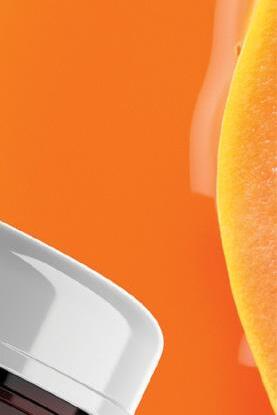

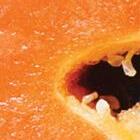























































































































































Trying to live more sustainably and reduce your personal waste while raising a family? An expert is here to help.
BY SARAH PROTZMAN HOWLETTFor author, scientist and mom Anita Vandyke, a zero-waste lifestyle means much more than being mindful of food and packaging waste. While those things are crucial, Vandyke’s new book, A Zero Waste Family in Thirty Days (Penguin, 2022), is a comprehensive guide to bringing peace into our home lives through simplifying. Here, she shares tips from the grocery and cooking portions of her book, plus her top family-friendly tips for reducing waste in the kitchen.

How families can reduce their use of plastic and still enjoy convenient, kid-friendly foods (like bars) and snacks. Apple, mango and other fruits dried in a dehydrator can be stored in air-tight glass jars and packaged in reusable silicone bags, Vandyke says. She also loves buying nuts in bulk and making her own trail mix with the dried fruit. “These snacks are easy to grab and go,” she says. “Whole fruits and vegetables that have been sliced up can also be put into silicone bags or a reusable container.”
How to engage kids in zero-waste efforts.
“I love baking with my children,” Vandyke says. “Getting them involved in the kitchen is a great way to educate them on where your food comes from, the effort required to make a
meal and how to prevent food waste.” She also upcycles jars to make her own bath products. “I’ve chosen to replace all my exfoliants with a DIY sugar scrub that costs less than $1 to make,” she says.


Most of us have hoarded food over the years, Vandyke says, more food than necessary even for emergency situations. Her recommendation: If you have too many cans of chickpeas, start researching recipes to use them up. If you have too many boxes of pasta, start using them in pasta bakes and other large meals. See it as a new challenge to eat down your stores and start afresh with a clean pantry. Also, make an “eat first” box that you place on the top shelf of your fridge with items close to their use-by date.
Want to buy natural products from companies committed to a more sustainable world?
Then check out Hive, an online marketplace where you can shop hundreds of natural and sustainable products from brands doing good, everything from pantry and snack foods, to cleaning products, household goods, personal care and pet products. Hive’s mission is to connect people who want to shop their values with brands who live those values. Shop at hivebrands.com

Eat more salad. It’s what most every dietitian recommends. But just as important as what you put in your salad is what you put on it: the dressing. And while most creamy dressings are higher in calories and fat than simple vinaigrettes, there are better-for-you options. Here are some of our favorites.

Avocado Oil Caesar Dressing & Marinade

Avocado Oil & Extra Virgin Olive Oil Dairy Free Ranch

Plant-Based Spicy Ranch Dressing
Cilantro Avocado Yogurt Dressing

Made with avocado oil and a kick of black pepper and organic spices, plus organic cage-free eggs and apple cider vinegar, this creamy dressing is free of soy, dairy, gluten and sugar, and is Whole30 approved, keto certified and paleo friendly.
2 TBSP: 130 CAL, 14G FAT (1.5G SATURATED FAT), 0G SUGAR, 210MG SODIUM
A blend of avocado and olive oils, plus cage-free egg yolks, mustard, vinegar and spices, this latest edition to the Newman’s Own line is paleo and keto certified; free of gluten, dairy, soy and sugar; and also kosher. Best of all, 100 percent of sale profits go to charity.
2 TBSP: 160 CAL, 18G FAT (2.5G SATURATED FAT), 0G SUGAR, 220MG SODIUM
This rich and tangy plant-based dressing is non-GMO, and dairy- and gluten-free. Made with water, canola oil and distilled vinegar, plus jalapeno peppers and other spices, its creaminess comes from cornstarch and yeast.

2 TBSP: 110 CAL, 11G FAT (1G SATURATED FAT), 1G SUGAR, 340MG SODIUM
Add a little zest to your greens with this Latininspired dressing. Made with yogurt—which helps keep the calorie count down—and no artificial preservatives or flavors, it features a delicious combo of creamy avocado, chopped cilantro, cotija cheese crumbles and poblano pepper bites.
2 TBSP: 40 CAL, 3.5G FAT (1G SATURATED FAT), 1G SUGAR, 150MG SODIUM
Avoid
Healthy snacks to keep you fueled in between meals or for active endeavors.

 BY REBECCA HEATON
BY REBECCA HEATON
Barnana takes humble bananas— plantains, too—and transforms them into great-tasting treats. Caue Suplicy, a former triathlete living in Brazil, came up with the idea for banana treats as a healthy energy snack when his father turned an old skylight into a solar dehydrator. Committed to upcycling bananas and plantains destined for the trash, Barnana works directly with more than 1,400 Indigenous farmers in Latin America who provide a steady supply of fruit for the company’s plant-based, USDA organic, nonGMO sweet and salty snacks. These partnerships and the company’s focus on sustainability earned it B Corps Certification. A recent addition to the snack lineup is Dipped Barnana Bites, made with premium chocolate.
Flavors: Dark Chocolate, Peanut Butter and Peanut Butter Cup
Crunchy PeaTos offer the flavor and fun of junk-food snacks like Cheetos and Funyuns but are made with betterfor-you ingredients like nutrient-dense peas (instead of corn). All ingredients are all-natural, non-GMO and free of gluten, dairy and artificial colors. Each serving has 4 grams of protein and 3 grams of fiber—more than two times that of their less-healthy counterparts. Although born in the U.S., PeaTos founder Nick Desai was inspired to create PeaTos by the salty snacks from his parents’ native India, which are made from a base of peas and lentils, instead of corn or potato as is common in the U.S.

Flavors: Classic Cheese Curls, Fiery Hot Curls, Classic Onion Rings and Crunchy Pizza Rings
It started with a mother and daughter (“Bobo”) baking homemade oat bars in their kitchen. Today, Bobo’s Oat Bars and Oat Bites are available nationwide. Still made by hand in small batches in Boulder, Colorado, with 100 percent whole-grain oats and other all-natural ingredients—including nut butter, fruit, organic coconut oil and brown rice syrup—the hearty snacks are nonGMO; kosher; and free of gluten, dairy and soy. Since day one, the company has supported local organizations by donating proceeds from limited-edition bars with specially designed labels. To show their appreciation during the COVID-19 pandemic for healthcare and education workers, Bobo’s created a “Hero” Chocolate Chip Oat Bar. With illustrations of a local nurse and teacher on the labels, all profits were donated to AdoptAClassroom.org.
Flavors: 15 flavors of Oat Bars and 10 flavors of Oat Bites

1
Once you start using these handy tools, there’s no going back.
BY REBECCA HEATONIf you love natural peanut butter but don’t love the oil that accumulates, the handy Chef’n Peanut Butter Stirrer allows you to easily mix the oil in without a mess. Twist the lid onto a 16- or 26-ounce jar, slide the stir wand through the slot, then slowly turn until everything is blended. The unique lid design scrapes peanut butter off the stir wand when removed from the jar. Dishwasher-safe. $14.99

2 RECYCLED SKILLET
Manufactured in Switzerland from 100 percent recycled aluminum, the Kuhn Rikon New Life Skillet is eco-friendly and efficient. The durable, nonstick pan is made from aluminum, one of the best materials for cookware, as it stores and spreads heat evenly for fast cooking. Featuring an ergonomic, heat-resistant handle, this pan can be used on the stovetop or in the oven up to 460°. Clean it by hand or stick it in the dishwasher. Available in 8-, 9.5- and 11-inch; $128–$156.


3
Organize snacks, bars, spices or other small items in a YouCopia Crazy Susan Turntable. Stash everything in the six removable bins with handles or the center cup; then spin and select what you want. Nonstick feet hold the turntable steady in a cabinet, or on a desk or table. Also works well for organizing small items in the bathroom, office, kids room or a craft room. $29.99

4 HANDY CHOPPER
Chop herbs, veggies and fruit for sauces, salsas and salads in a snap with the Kuhn Rikon Pull Chop. A few pulls on the handle rotates blades inside this manual “food processor”— the more you pull, the finer the ingredients are sliced and diced. Also handy for chopping ingredients like nuts, boiled eggs and breadcrumbs. A storage lid lets you store ingredients in the fridge until ready to use. Dishwasher-safe, too. $32

5 ECO CUP
You can feel good about drinking hot or cold beverages from a MiiR Climate+ Tumbler. The spill-proof lid is made from 100 percent recycled plastic—that can also be recycled— and the double-wall, vacuuminsulated cup uses 25 percent less stainless steel than other equivalent cups. Plus, a percentage of every sale goes to organizations working on social and environmental change. Available in 12- and 16-ounce sizes. $24.95–$29.95




In his new book, Jones shares his wealth of knowledge and how regenerative agriculture is a key to growing the best-tasting and highest-quality produce.
 BY REBECCA HEATON
BY REBECCA HEATON
Best known for his overalls and bow tie, Farmer Lee Jones and his team use regenerative farming techniques to grow more than 600 varieties of delicious and nutritious vegetables, microgreens and herbs on his family’s 350-acre farm, The Chef’s Garden, by Lake Erie in Huron, Ohio. Dubbed a “farmer to the stars,” Jones regularly provides produce to worldrenowned chefs, like José Andrés and Wolfgang Puck, along with high-end hotels and restaurants. When the pandemic hit, the farm lost 95 percent of its clients (most or all are back now), so it pivoted and launched Farmer Jones Farm Home Vegetable Delivery for “regular” folks nationwide, which continues today. In between working on the farm and managing all his client accounts, Jones found time to write The Chef’s Garden (Avery, 2021), a comprehensive guide to common and unusual vegetables, with recipe ideas developed by full-time chefs on his farm staff. We chatted with him to learn more.

“Since as early as the 1930s, the nutritional level of vegetables has gone down dramatically,” says Jones. “As many farmers continue to farm largescale and use GMO crops and synthetic fertilizers, they’re killing all the microbial action in the soil, so plants have fewer nutrients to pick up.” But Jones is committed to the belief that everything starts with health and balance of the soil. So half of his 350-acre farm is always planted in a rotation of cover crops like alfalfa, clover, wheat and mint to “harvest the sun’s energy” and allow nutrients to rebuild for planting vegetables. “As far back as the 1950s, my dad incorporated crop rotations and would say, ‘We’re going out to harvest some vitamin D’—there is so much truth to that.”
“It takes about three years to rebuild soil,” Jones explains. “We’ll grow one cover crop, mow it down and plow it in, then grow another cover crop. In our lab, we’re testing nutrient levels to 300–500 times higher than the USDArecommended average.”
Scientists on Jones’ staff then test vegetables grown in the rebuilt soil and are continuously discovering that the produce is very nutrient dense. “We’re really excited about this and continue to learn—we’re on the cusp!” says Jones. “We believe that there is a direct correlation to the health of our nation and the vegetables we’re consuming: healthy soil, healthy vegetables, healthy people, healthy environment.”
“I’m really partial to eating seasonally. There’s a reason there are winter vegetables,” says Jones. “I think your body sometimes craves certain foods. There are times I need Swiss chard, other times I need beets.” Jones suggests listening to your body as there are certain minerals and nutrients that it’s looking for. “Eat the rainbow,” he adds, “and anytime that you can eat things raw, do it, because when you cook, food can lose up to 50 percent of its nutritional value.”
Celery root.
“This vegetable is very underrated. It stores well and is fabulous to put in with mashed potatoes, adding a nice, clean additional flavor—somewhat minty— and texture,” says Jones. Kohlrabi. “This vegetable is also underrated. It’s very popular in Europe, but not in the U.S. When we did farmers’ markets in the 1980s, Europeans knew what it was. (Chef) Wolfgang Puck has been on the farm a few times, and he’ll eat it just like an apple,” says Jones. Try slicing it thin on a salad or steaming it with a bit of cracked salt.
Brussels sprouts.
“Brussels sprouts are majestic and gorgeous, and loaded with vitamin C. They take all seasons to grow.
I would defy any of your readers to be able to tell the difference between a Brussels sprout leaf and a collard green,” says Jones.

Ice Cream
Sandwiches
MAKES 6 TO 8 DOUBLE-DECKER
ICE CREAM SANDWICHES
CARROT CAKE
Nonstick cooking spray
½ cup allpurpose flour
½ cup sugar
½ tsp baking soda
½ tsp ground cinnamon
½ tsp ground nutmeg
¼ tsp salt
1 large egg
1⁄3 cup vegetable oil, such as grapeseed
¾ cup finely grated carrot
SWEET PEA
ICE CREAM
¾ cup milk
1¼ cups heavy cream
5 large egg yolks
½ cup sugar
Pinch of salt
1 cup blanched fresh or thawed frozen English peas
1 cup pea tendrils
4 oz cream cheese
1. Carrot cake: Preheat the oven to 350º. Line three 1 /8 sheet pans (6 x 9 inches) with parchment paper and spray with cooking spray. (Or line a ½ sheet pan with parchment paper.)
2. In a large bowl, combine the flour, sugar, baking soda, cinnamon, nutmeg and salt.
3. In a small bowl, combine egg and oil, then add egg mixture to the flour mixture and stir. Fold in the grated carrot.
4. Divide the batter evenly among the pans and smooth the tops. (Alternatively, spread the batter to cover three-fourths of the sheet pan.) Bake until set, about 15 minutes. Let the cake cool, then invert to unmold onto a rack. Pull off the paper. If you baked 1 large cake, cut the cake into 3 even rectangles. Line a platter or baking sheet with parchment paper and arrange the cakes in a single layer on a platter or sheet and freeze for 2 to 12 hours.
5. Sweet pea ice cream: In a medium saucepan, heat milk and cream over low heat and keep at a very low simmer. In a large bowl, vigorously whisk the egg yolks, sugar and salt for a few minutes, until fluffy and almost marshmallow-like in texture. In a thin stream, gradually add cream mixture while whisking constantly. Transfer mixture to a high-speed blender and add the peas, pea tendrils, a pinch of salt and the cream cheese. Blend on high speed until everything is fully incorporated and the temperature reaches 172º
6. Set a large bowl above an ice bath and transfer the ice cream base to it. Let stand, stirring occasionally, until cool. (Alternatively, chill the ice cream base in the refrigerator for at least 4 hours.)
7. Pour ice cream base into an ice cream maker and freeze according to the manufacturer’s instructions. Freeze until you are ready to use but do not allow it to get firm; it needs to be soft for spreading.
8. Remove the cakes from the freezer. Working on the frozen platter or baking sheet lined with parchment paper, spread half the ice cream over one of the cakes. Top with another cake and spread
with the remaining ice cream. Top with the third cake so you have a double-decker ice cream sandwich. Wrap in the parchment paper and freeze the sandwich until firm, at least 4 hours. When solid, use a serrated knife to cut into individual ice cream sandwiches as desired (cleaning the knife as necessary between cuts). Serve immediately or wrap individually in parchment paper, then return to the freezer until you want to serve.
PER SERVING: 613 CAL; 7 G PROTEIN; 41 G CARB (32 G SUGARS); 288 MG SODIUM; 1 G FIBER

HERE ARE SOME OF OUR FAVORITE RECIPES FROM THE CHEF’S GARDEN
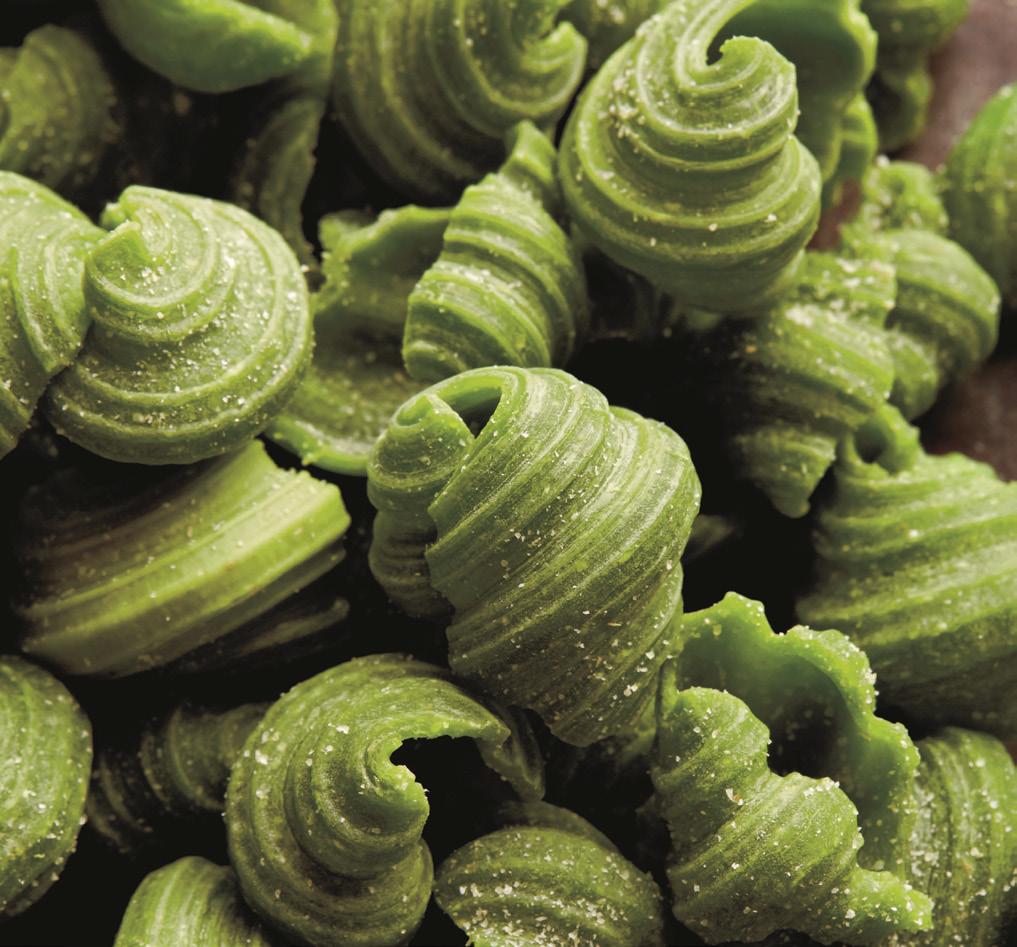
MAKES ABOUT 1 POUND FRESH PASTA
1¼ cups
all-purpose flour
1 cup plus 2 Tbsp
semolina flour
¾ cup fresh vegetable juice
¼ tsp salt
½ tsp
extra-virgin olive oil
1. In a medium-sized bowl, whisk together the flours.
2. In a measuring cup, combine the vegetable juice, salt and olive oil; stir them gently to combine.
3. Add the wet ingredients to the flours and stir them together to form a dough. Transfer the dough to a work surface, and knead until it is homogenous and smooth, 6 to 8 minutes. (If the dough is sticking, you can flour the surface. If the dough seems dry, you can sprinkle on a few drops of water at a time and incorporate.) Cover the dough with plastic or place it in a resealable bag, and let rest for 30 minutes.
4. To form cavatelli, pull off one small piece of dough at a time. On a floured work surface, roll the piece into a rope that’s about ¼ inch in
diameter. Slice the rope into ¼-inch pieces. Using two fingers, pull each dough piece toward you until it flattens in the middle and curls up on either side of your fingers. Transfer to a parchment-lined baking sheet and let stand while you form the rest of the dough. Let the pasta stand 30 minutes before cooking.
5. If you plan to cook the pasta right away, do so in a large pot of boiling salted water. Cook for 3 minutes, then taste it every 45 seconds after. Drain when cooked to al dente.
6. If you prefer to save the pasta, let it stand for 2 hours, until somewhat dry. Then transfer to a resealable bag and refrigerate for up to 5 days, or freeze for up to 3 months.
PER SERVING (6 PER LB): 205 CAL; 7 G PROTEIN; 41 G CARB (1 G SUGARS); 151 MG SODIUM; 2 G FIBER
EXCERPTED FROM THE CHEF’S GARDEN: A MODERN GUIDE TO COMMON AND UNUSUAL RECIPES—WITH RECIPES © 2021 BY FARMER LEE JONES. REPRODUCED BY PERMISSION OF AVERY, AN IMPRINT OF PENGUIN RANDOM HOUSE.
NUTRITIONAL VALUES CALCULATED AT HAPPYFORKS.COM/ANALYZER

SERVES 4
3 slices day-old sourdough bread, cut into cubes
¼ cup plus 2 Tbsp extra-virgin olive oil
Kosher salt
Freshly ground black pepper
1 cup Basic Pickle Brine (see below)
1 lb large asparagus, preferably multiple colors, snapped-off ends reserved for dressing
½ cup buttermilk
¼ cup chopped fresh chives, plus more for garnish
¼ cup chopped fresh parsley, plus more for garnish
1 garlic clove
2 tsp onion powder
1 orange, peel removed, orange segmented
1. Preheat the oven to 325°. On a rimmed baking sheet, toss bread cubes with 2 Tbsp of olive oil, and season with a little salt and pepper. Bake for 25 minutes, stirring once or twice, until crisp. Let cool slightly, then break into coarse crumbs.
2. In a small saucepan, bring brine to a boil. Meanwhile, remove tips of asparagus at 1½ inches. Add them to brine and remove from heat. Blanch until bright green, about 30 seconds. Drain. (After brine cools, you can store pickled tips in it, if desired.)
3. Shave the asparagus stalks lengthwise using a sharp
peeler, without turning the vegetable. You will begin creating ribbons by peeling all the way through the vegetable to the other side. Transfer these ribbons to a bowl of ice water. Reserve any pieces that will not shave easily for the dressing.
4. In a blender, combine all of the asparagus trim, including reserved asparagus ends and unshaven pieces, buttermilk, chives, parsley, garlic, onion powder, 1 tsp salt and a few cracks of pepper and blend on high. Reduce speed to medium and gradually pour in remaining ¼ cup olive oil until fully incorporated. Taste and season dressing with more salt and pepper, if desired. Strain through a sieve into a jar or bowl. (You can store in an airtight container in the refrigerator for up to 1 week.)
5. Remove shaved asparagus from ice water, allowing the excess water to drip off. Season with some salt. Arrange ribbons in center of each of four serving plates. Scatter some bread crumbs on the asparagus. Spoon dressing over asparagus ribbons and crumbs. Place pickled asparagus tips in the open places. Garnish with orange segments, and finish with more parsley and chives. Add half a turn of the pepper to each of the salads and serve.
PER SERVING: 466 CAL; 16 G PROTEIN; 67 G CARB (12 G SUGARS); 981 MG SODIUM; 6 G FIBER
In a medium saucepan, bring 4 cups filtered water and 1 cup white vinegar to a boil. Add ½ cup sugar and 1 tsp fine sea salt and stir to dissolve. Let cool, then refrigerate for up to 4 weeks to use for making pickled asparagus tips.BASIC PICKLE BRINE 5 CUPS
For ease of preparation, pickle onions ahead. Cook potatoes and chill.
Cook and chill eggs.
Cook potatoes and roast asparagus.
Refrigerate for up to a day and assemble when ready to serve.
NI Ç OISE WITH SMOKED SALMON, JAMMY EGGS & BRILLIANT
This beautiful Niçoise has it all— color, flavor and buttery smoked salmon SERVES 6

SALAD
1 cup thinly sliced red onion
1 Tbsp fresh lemon juice
½ tsp raw sugar
¼ tsp sea salt
4 medium organic eggs
½ lb small new potatoes or unpeeled blue potatoes
1 lb fresh asparagus
2 cups frisée or mixed baby greens
½ head radicchio, leaves separated
6 oz cold-smoked wild salmon
½ cup bright green olives, such as Castelvetrano
1 Tbsp capers, rinsed and drained (optional)
2 Tbsp fresh lemon juice
1 Tbsp fresh minced tarragon
2 tsp Dijon mustard
1 grated or finely minced garlic clove
½ tsp raw sugar or honey
¼ tsp black pepper
3 Tbsp extravirgin olive oil or camelina oil
Sea salt, to taste (optional)
1. In bowl, place onion slices, lemon juice, sugar and salt. With your hands, massage onions until tender and pink, about 2 minutes. Chill in tightly covered glass container until ready to use. These can be made several days ahead.
2. Bring large saucepan of water to a boil over medium-high heat. With slotted spoon, carefully place eggs into simmering water. Return to a simmer, cover and cook for 6 minutes. Drain and place eggs in bowl of ice water and chill until slightly warm. Remove and set aside until cool enough to peel. Refrigerate.
3. Place steamer basket in pan, add potatoes, and cover tightly. Bring to a boil and steam until potatoes are fork-tender, about 15 minutes. Alternatively, in large saucepan of boiling salted water, cook whole potatoes until fork-tender, about 10 minutes. Drain and, when cool enough to handle, slice in half. Refrigerate.
4. Preheat oven to 350º. Snap off and discard tough ends from asparagus. Lightly oil asparagus spears and place in single layer on baking sheet. Bake for 10 minutes, or until tender but still crisp. Remove and refrigerate.
5. In small bowl, combine lemon juice, tarragon, mustard, garlic, sugar and pepper. Gradually whisk in oil until emulsified. Add salt to taste, if you wish. Refrigerate.
6. When ready to serve salad, arrange frisée and radicchio on platter. Top with drained, pickled onion and roasted asparagus. Halve jammy eggs and place on top along with smoked salmon and olives, and capers, if using.
7. Give dressing a quick whisk and drizzle overtop. Serve at room temperature or cold.
PER SERVING: 223 CAL; 9 G PROTEIN; 13 G FAT; 16 G CARB (4 G SUGARS); 448 MG SODIUM; 3 G FIBER
Folate is a B vitamin naturally present in asparagus and is essential for forming healthy DNA and other genetic materials. It’s especially important for pregnant women to facilitate the healthy division of cells.
Dark leafy vegetables coupled with asparagus and artichokes create a combo of flavors that virtually pop in your palate. SERVES 4 TO 6
1 tsp coriander seeds
½ tsp fennel seeds
½ tsp black peppercorns
Zest and juice from 1 lemon
½ cup extra-virgin olive oil
2 sprigs fresh thyme
1 large garlic clove, smashed and minced
1 lb asparagus spears, trimmed
2 cups spring greens (lamb’s lettuce and baby spinach leaves)
14 oz can artichoke hearts, drained
4 large radishes, thinly shaved
2 Tbsp tahini
¼ tsp smoked paprika
¼ cup walnut halves, toasted
1. In a small, heavy saucepan, add coriander, fennel and peppercorns. Toast in dry pan until aromatic and seeds begin to pop, about 1 minute. Transfer to mortar and pestle and lightly crush. Return to saucepan along with lemon zest, oil, thyme and garlic. Simmer over medium-low heat until garlic begins to sizzle, about 5 minutes. Remove from heat, cover pan with lid, and set aside for 15 minutes for flavors to blend.
2. In medium bowl, place some ice cubes and fill with water. Set aside. Bring medium saucepan of water to a boil. Set a couple of raw asparagus spears aside for garnish. Add remaining asparagus spears to boiling water and briefly blanch until bright green but still crisp, about 1 to 2 minutes, depending on thickness of asparagus. Immediately drain and place asparagus in ice water to stop the cooking. Remove and blot dry.
3. On large platter, artfully arrange asparagus and spring greens into the shape of a bouquet. Quarter artichoke hearts and blot dry. Tuck into arrangement along with shaved rounds of radishes.
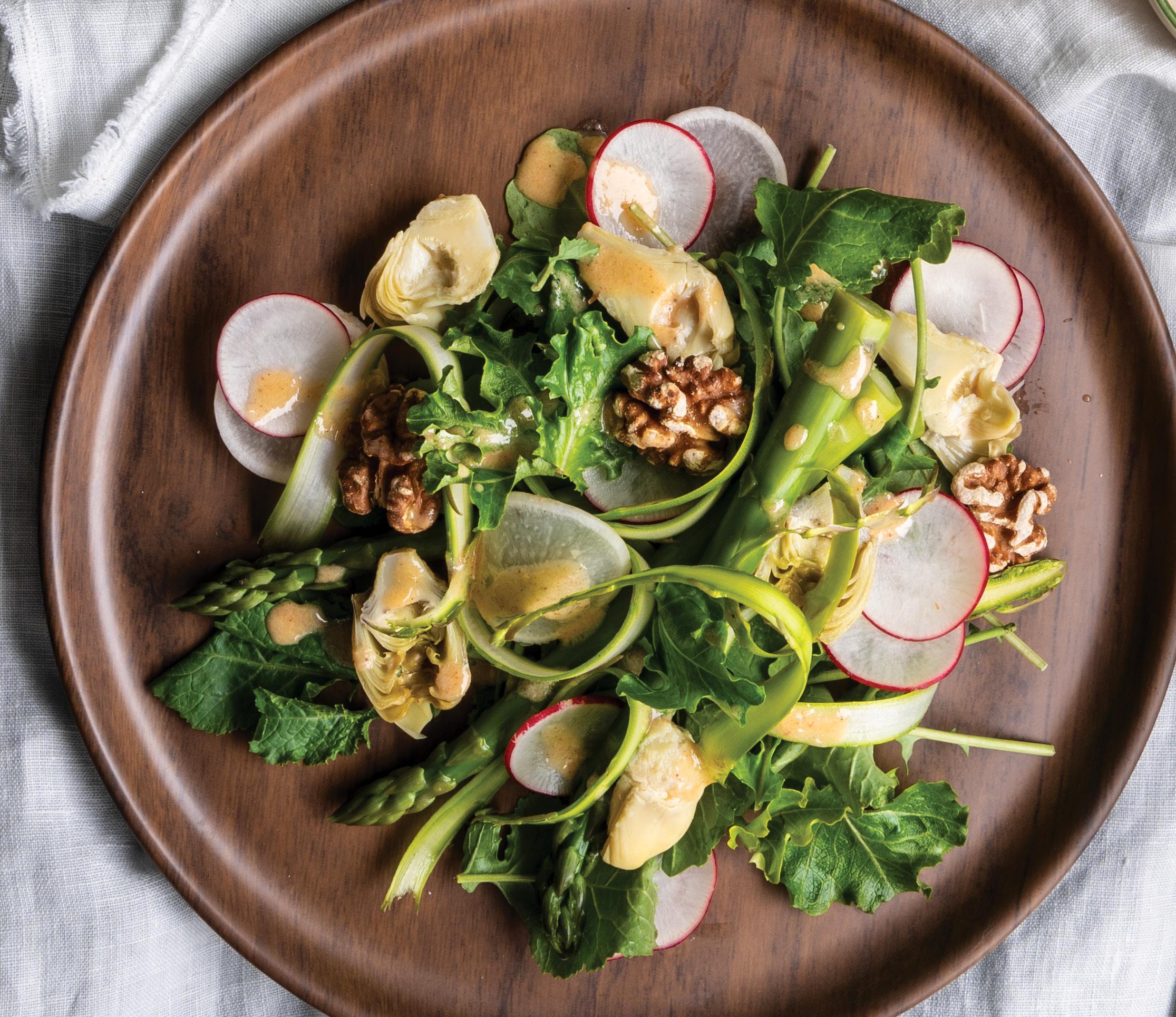
4. In small bowl, combine lemon juice, tahini and paprika. Strain infused garlic oil into lemon juice and whisk thoroughly to fully emulsify. Drizzle 2 to 3 Tbsp dressing overtop the asparagus bouquet and sprinkle with toasted walnuts. Thinly shave 2 raw asparagus spears lengthwise and twist overtop of salad. Add a sprinkle of flaked salt if you wish. Refrigerate remaining dressing for up to 1 week to use for another dish.
PER SERVING: 277 CAL; 6 G PROTEIN; 24 G FAT; 14 G CARB (3 G SUGARS); 294 MG SODIUM; 6 G FIBER
Matthew Kadey is a dietitian, nutrition writer and recipe developer. He is also the author of Rocket Fuel (VeloPress, 2016) and Muffin Tin Chef (Ulysses Press, 2012).
Couscous and cumin seeds can be replaced with cooked orzo pasta and ½ tsp ground cumin. Spinach can be replaced with baby kale leaves and folded into warm couscous.
 BY IRENE M c GUINNESS
BY IRENE M c GUINNESS
This salad is fresh and satisfying.
SERVES 6
1 cup Israeli couscous (also called large couscous)
1 tsp cumin seeds
1 ½ cups low-sodium vegetable stock
¼ cup golden seedless raisins
Finely grated zest and juice from 1 lemon
2 Tbsp extravirgin olive oil
1 small garlic clove, smashed and minced

¼ tsp sea salt
¼ tsp freshly ground black pepper
3 cups baby spinach leaves, washed and spun dry
¼ cup red onion, finely diced
¼ cup chopped cilantro
2 Tbsp chopped fresh mint
¼ cup chopped walnuts, toasted
2 Tbsp crumbled feta
1. In large, dry saucepan over medium-high heat, toast couscous for 2 minutes or until pearls begin to turn color. Stir often. Stir in cumin seeds and continue to toast for 1-2 more minutes, stirring often.
2. Slowly add vegetable stock, as it will sputter, and bring to a gentle simmer. Cover and simmer couscous for about 10 minutes, or until couscous has absorbed all the liquid and is tender-cooked but still has a little bite. Remove from heat and set aside, covered, for another 10 minutes. Drain, if necessary.
3. In small bowl, combine raisins with ½ cup hot water and set aside to soak and become plump, about 10 minutes.
4. In large bowl, combine lemon zest and juice, olive oil, garlic, salt and pepper. Whisk together to blend. Add warm cooked couscous, spinach, red onion, cilantro and mint. Drain raisins and add. Fold together to evenly blend and slightly wilt spinach.
5. Taste and add more lemon, salt and pepper if you wish. Scatter walnuts and feta overtop. Serve slightly warm or at room temperature. Or cover and refrigerate and serve chilled the same day or next.
PER SERVING: 244 CAL; 8 G PROTEIN; 9 G FAT; 37 G CARB (6G SUGARS); 331 MG SODIUM; 5 G FIBER

 BY JENNY ROSENSTRACH
BY JENNY ROSENSTRACH
The pasta and pesto each take about the same time to prepare.
SERVES 4
PESTO) (CONTINUED FROM PAGE 21)
Kosher salt, to taste
16 oz spaghetti
½ cup frozen peas
1 lb broccolini, trimmed and chopped into 2-inch pieces
2 Tbsp unsalted butter
¼ cup Kale Pesto or store-bought basil pesto
KALE PESTO (MAKES ¾ CUP)
Kosher salt to taste
4 cups torn curly kale, tough stems removed
½ large clove garlic, roughly chopped
3 Tbsp grated Parmesan cheese
Freshly ground black pepper, to taste
¼ cup raw blanched almonds
3 Tbsp fresh lemon juice
½ tsp honey
1⁄3 cup olive oil
SERVING
Grated Parmesan cheese
Freshly ground black pepper to taste
1. Kale Pesto : First, blanch kale. Bring a pot of salted water to a boil and add kale. Cook until wilted, about 2½ minutes. Transfer kale to a bowl of water and ice to preserve its bright-green color. Drain and cool. Place leaves between two paper towels and wring out as much moisture as you can.
2. In blender or food processor, pulse kale, garlic, Parmesan, salt, pepper, almonds and 2 Tbsp lemon juice until coarsely chopped. Add honey and olive oil and continue to pulse. Taste and adjust with remaining lemon juice until pesto is a drizzling consistency. Store in refrigerator, covered, for up to 1 week.
3. Pasta : Bring large pot of salted water to a boil. Cook pasta according to package directions until al dente. About 2 minutes before you drain pasta, add peas and broccolini to the pot. Reserve ½ cup of pasta water, then drain pasta, peas and broccolini in a strainer. Add butter to everything in strainer and toss well.
4. Return pot to the stovetop (without heat) and add pesto. Slowly whisk in reserved ½ cup pasta water until pesto is thinned but not brothy. Add spaghetti and vegetables and toss until pesto is well distributed. Serve with grated Parmesan and some freshly ground black pepper.
PER SERVING: 291 CAL; 12 G PROTEIN; 13 G FAT; 35 G CARB (1 G SUGARS); 184 MG SODIUM; 9 G FIBER
ADAPTED FROM THE WEEKDAY VEGETARIANS. COPYRIGHT © 2021 BY JENNY ROSENSTRACH. PHOTOGRAPHS COPYRIGHT © 2021 BY CHRISTINE HAN. PUBLISHED BY CLARKSON POTTER, AN IMPRINT OF RANDOM HOUSE.
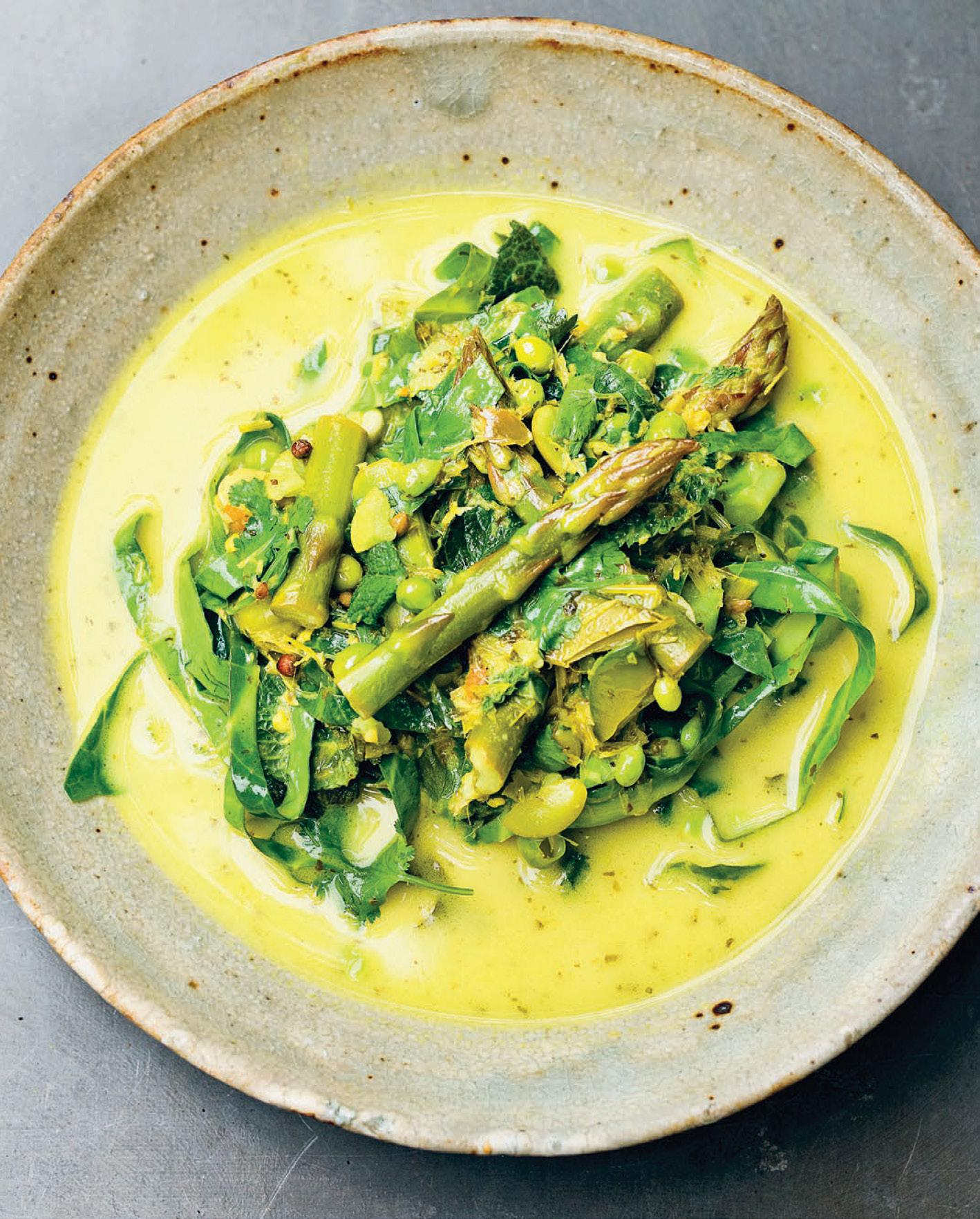 BY NIGEL SLATER
BY NIGEL SLATER
This flavorful dish is both vibrant and verdant.

SERVES 2-4
FOR THE CURRY PASTE
1 tsp white peppercorns
1 tsp coriander seeds
1 tsp ground turmeric
2 stalks lemongrass
2 cloves, peeled garlic
1¼-inch piece ginger, peeled
3 small and hot green chiles
4 Tbsp peanut oil
Handful fresh cilantro, with roots
FOR THE DISH
3 lightly heaped Tbsp curry paste (from above)
¾ cup plus 2 Tbsp vegetable stock
1 cup coconut milk
1 Tbsp fish sauce
2 Tbsp lime juice
1 lb spring vegetables (such as asparagus tips, fava beans, peas)
Couple handfuls of shredded greens (such as spring cabbage)
Pinches of sugar & soy sauce

1. Make the paste: Put the white peppercorns and coriander seeds in a dry nonstick frying pan and toast lightly for 2 or 3 minutes, then tip into the bowl of a food processor and add ½ teaspoon of sea salt, turmeric, lemongrass, garlic cloves, ginger, green chiles, 3 Tbsp peanut oil and cilantro stems and roots. Blitz to a coarse paste. (You can keep this paste for a few days in the fridge, its surface covered with peanut oil to prevent it from drying out.)
2. In a deep pan, fry 3 lightly heaped Tbsp of the curry paste in the remaining 1 Tbsp of oil for 30 seconds until fragrant, stirring as you go. Stir in vegetable stock, coconut milk, fish sauce and lime juice.
3. Add the spring vegetables and continue simmering for 5 to 6 minutes, then drop in the greens. Finish the curry with more fish sauce and lime juice and pinches of sugar and soy sauce.
PER SERVING: 470 CAL; 12 G PROTEIN; 35 G FAT; 34 G CARB; 704 MG SODIUM; 8 G FIBER
SLATER. PUBLISHED BY TEN SPEED PRESS.
Who said pancakes have to be sweet? Serve these for a weekend brunch.
SERVES 4
PANCAKES
1 garlic clove, peeled
Handful of fresh coriander
Handful of spinach
½ tsp ground cumin
½ tsp ground cardamom
3½ fl oz milk or oat milk, plus extra if needed
4½ oz spelt flour
2 large eggs
1-2 Tbsp butter
Salt and pepper
TOPPING
1 avocado, cut into chunks
2 spring onions, finely sliced
2 handfuls of spinach
2 Tbsp milk kefir 1 (7 oz) can of sweet corn, drained ½ Tbsp chili flakes
Squeeze of lemon juice
1. Put garlic, coriander, spinach, cumin and cardamom in a blender and blitz to a smooth green paste. Add a splash of the milk or oat milk to loosen if needed.

2. Add flour to a large mixing bowl and create a well, then add eggs, slowly whisking them into the flour. Add a pinch of salt and stir, then gradually add milk, followed by the green paste, and whisk to combine. Leave to rest for 20 minutes at room temperature.
3. Put all topping ingredients in a mixing bowl, season with salt and pepper, and stir to combine.
4. Melt butter in an 8-inch nonstick frying pan over medium heat. Once hot, whisk the batter, then ladle 4 Tbsp into the pan. Cook 2 minutes, then flip and cook for a further minute. Transfer to a plate and repeat, serve with the mixed topping. Store any leftover pancakes in an airtight container in the fridge for 3-4 days. The topping is best prepared and served immediately.
PER SERVING: 349 CAL; 13 G PROTEIN; 18 G FAT; 40 G CARB (6 G SUGARS); 159 MG SODIUM; 9 G FIBER
EXCERPTED FROM THE GUT-LOVING
COOKBOOK © 2022 BY ALANA & LISA

From a simple seed planted in the ground with a little water, nutrients from the soil, and a whole lot of energy from the sun, comes the wholesome nutrition that sustains our lives.


wholeearthsea.com

Factors Farms are certified 100% organic. Our crops are fertilized with compost and nitrogenrich sea plants, and are meticulously cared for by hand.
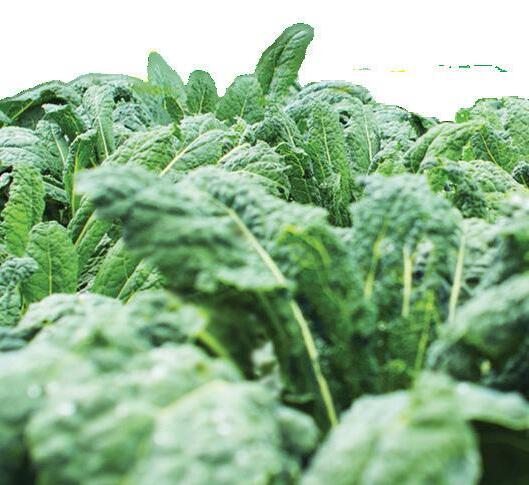

This is the vision that created the greatest multivitamins ever.


WHOLE EARTH & SEA AVAILABLE AT YOUR LOCAL NATURAL HEALTH STORE













“This is the single best thing to help relieve allergy symptoms,” says Rountree. A nasal saline wash will help to clean out all the dust and “crud” in your nose.

This antioxidant is known to help stabilize mast cells, which release histamine into our bloodstream when they detect allergens. But it has to be taken regularly starting at least a month ahead of allergy season. If you’re eating fruits and veggies, you’ll get about 100 mg of quercetin daily. As an allergy supplement, Rountree recommends 2,000–3,000 mg daily.
Well-documented to support a healthy immune system, vitamin C works on a cellular level to protect against damage from toxins and the oxidative stress of free radicals. When the latter is left unchecked, it can lead to chronic health issues. It can also help to blunt histamine production. To garner this level of allergy support, a recommended dose is 2,000 mg daily.
In the large body of research on vitamin D, there is evidence that it is helpful for regulating the immune system, which can help improve the body’s tolerance to invaders. Rountree recommends 1,000–2,000 IU daily.
These healthy fats have been shown to have antiinflammatory properties, which help cool off the immune system so it’s less reactive. They can be found in foods such as avocados and seafood. A recommended daily dose is 250–500 mg (combined DHA and EPA).
Five natural supplements to help our bodies remove everyday toxins.
BY HEIDI FRITZThe term “detoxification” refers to biological processes responsible for safely removing harmful substances from the body. This involves the coordination of several body systems, including the circulatory system, liver, intestines, kidneys and more. Shifting our diet and lifestyle patterns, as well as providing higher amounts of certain nutrients to the body, can help enhance this process.
Every day, the body needs to process and eliminate many kinds of “toxins.” These may include metabolites from normal cellular functions such as CO2 , lactic acid, urea and hormones (like estrogen). It can also include substances that we may be exposed to through our food and environment, such as caffeine, alcohol, refined sugars, food additives, tobacco, chemicals from cosmetics, cleaners and pollution from industry.
Different sorts of toxins may be eliminated through different routes, such as through the lungs, the skin (via sweat), the kidneys and the liver-gut pathway. This pathway plays a particularly important role in detoxification, rendering toxic substances safe for elimination through the intestines. But if bowel material is not eliminated from the body in a timely manner, these toxins can be reabsorbed into the bloodstream and
recirculated throughout the body in a process called enterohepatic recycling. Symptoms of overloaded detoxification pathways may include fatigue, headaches, irritability, skin rashes, and digestive problems such as bloating and constipation.
It’s important to maintain a healthy routine so the body can effectively flush out toxins. The foundation of any well-designed detoxification program includes:
Reduction in the burden of toxins ingested through the diet
Regular exercise to increase circulation and sweating
The normalization of bowel function to enhance elimination through the liver-gut pathway Adequate water intake
Certain natural supplements such as the following may also enhance the body’s detoxification process.
Boosted by probiotics, gut flora contribute to the breakdown and elimination of metabolites in the digestive system. In lab studies, probiotic supplementation has been shown to reduce enterohepatic recycling of bile salts and increase cholesterol excretion through the gut.
Add extra fiber to your diet with ground flaxseed or oat fiber; these act as a “mop” to soak up and bind toxins in the gut for elimination.
NAC is one of the most important antioxidants involved in detoxification reactions in the liver. It can assist in neutralizing and packaging up toxins for excretion.
Used as a gentle laxative and muscle relaxant, magnesium may also help promote regular bowel function and elimination. Be sure to check with your health care practitioner before taking a magnesiumbased laxative.
A well-researched plant, milk thistle contains flavonoid antioxidants, known collectively as silymarin, that have membranestabilizing properties and have been shown to help reduce inflammation and regenerate liver cells exposed to toxic injury.
Center in Ontario, Canada.



NATURAL
SOURCE

SCAN HERE TO ORDER THESE NATURAL SUPPLEMENTS ONLINE! Vitacost.com is your source for natural, organic vitamins and supplements.











It’s fast + fun, with zero commitment!
A flowering plant in the daisy family also known as “pot marigold” and native to Central Europe and the Mediterranean, calendula has been used since the 12th century as a topical medicine. Supportive for most anything that ails the skin, including cuts, abrasions, wounds, irritations, rashes, eczema, infections, sunburn and burns (even those from radiation treatments), calendula is now most commonly used in cosmetic products, especially in formulations for sensitive skin or for soothing purposes. Rich in flavonoids and carotenoids, calendula is antimicrobial and an antioxidant but is believed to exert its greatest effects because of its strong antiinflammatory properties.
In addition to its topical benefits, when taken as a tea of tincture, calendula can support the gastrointestinal system, helping heal peptic ulcers (often caused by H. pylori infection or the overuse of pain relievers such as aspirin) and diarrhea. It may also clear up yeast infections. Additionally, it has long been used to help relieve anxiety.
A 2021 study found that calendula inhibits nitric oxide, which is created in inflammatory responses in the skin—and does a better job of this than chamomile or the herb gotu kola. A 2019 review paper found particularly strong results with calendula on acute wound healing, showing a
faster resolution of inflammation. Calendula was the subject of a clinical trial on yeast infection, in which the herb had a slower but longer-lasting effect than standard OTC treatment. Finally, researchers are also looking at further-reaching effects: A 2021 study reported that calendula may inhibit pancreatic cancer cell growth.
Calendula is available topically and as a tincture, capsule and tea. For internal use the recommended dose of calendula is 1,000–2,000 mg, one to three times daily. Avoid calendula if you have an allergy to any plant in the daisy family.



Raw Probiotics from Garden of Life offer raw, whole food, full spectrum, high-potency formulas with up to 38 beneficial probiotic strains. Available in age- and gender-specific formulas to support digestive and immune health and promote overall wellbeing.† Find us in the cooler!









